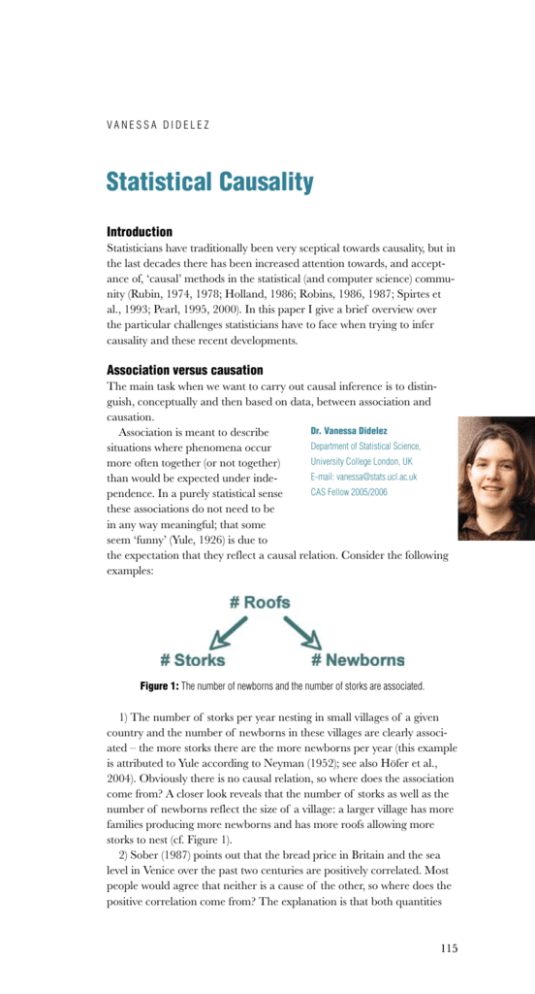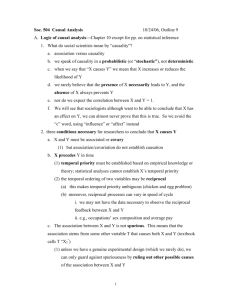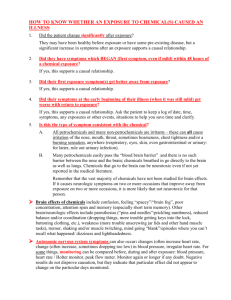Statistical Causality - School of Mathematics
advertisement

V anessa D idele z Statistical Causality Introduction Statisticians have traditionally been very sceptical towards causality, but in the last decades there has been increased attention towards, and acceptance of, ‘causal’ methods in the statistical (and computer science) community (Rubin, 1974, 1978; Holland, 1986; Robins, 1986, 1987; Spirtes et al., 1993; Pearl, 1995, 2000). In this paper I give a brief overview over the particular challenges statisticians have to face when trying to infer causality and these recent developments. Association versus causation The main task when we want to carry out causal inference is to distinguish, conceptually and then based on data, between association and causation. Dr. Vanessa Didelez Association is meant to describe Department of Statistical Science, situations where phenomena occur University College London, UK more often together (or not together) E-mail: vanessa@stats.ucl.ac.uk than would be expected under indeCAS Fellow 2005/2006 pendence. In a purely statistical sense these associations do not need to be in any way meaningful; that some seem ‘funny’ (Yule, 1926) is due to the expectation that they reflect a causal relation. Consider the following examples: Figure 1: The number of newborns and the number of storks are associated. 1) The number of storks per year nesting in small villages of a given country and the number of newborns in these villages are clearly associated – the more storks there are the more newborns per year (this example is attributed to Yule according to Neyman (1952); see also Höfer et al., 2004). Obviously there is no causal relation, so where does the association come from? A closer look reveals that the number of storks as well as the number of newborns reflect the size of a village: a larger village has more families producing more newborns and has more roofs allowing more storks to nest (cf. Figure 1). 2) Sober (1987) points out that the bread price in Britain and the sea level in Venice over the past two centuries are positively correlated. Most people would agree that neither is a cause of the other, so where does the positive correlation come from? The explanation is that both quantities 115 Statistical Causality have steadily increased over time due to their respective local conditions which are not further related to each other (cf. Figure 2). Hence it is two unrelated time trends that induce an association. Figure 2: Bread price in Britain and water level in Venice both exhibit a time trend. There is no single agreed on definition of causality in the statistical and philosophical literature. In the statistical literature one can distinguish at least four broad approaches: (i) probabilistic causality, reducing the question of causality to probabilistic statements among suitably defined events; (ii) counterfactual causality, addressing the question of “what if something had been different in the past”; (iii) structural models, assuming that the system of interest is driven by stable (stochastic) mechanisms this approach addresses under which condition these mechanisms can be uncovered; (iv) decision theory, addressing the question of making optimal decisions under uncertainty. Maybe except for (i) all of these approaches deal, more or less explicitly, with causation as the effect of an intervention in one (or more) variable(s) on some response variable. Typically, scientists are interested in causal relations because they want to intervene in some sense, to prevent diseases or to make life easier etc. Some examples: 1) It is well known that the increase of CFC use has been accompanied by ozone depletion, i.e. there is a clear association between the two. The underlying photochemical processes are by now studied and understood well enough to say that CFC is the cause of the ozone depletion. Hence we would expect that reducing the level of CFC (by some intervention!) will slow down or even reverse the ozone depletion. The Montreal Protocol signed by 43 nations in 1987 could be regarded as such an intervention to reduce and phase out the use of CFC. 2) We can be pretty sure that manipulating the number of storks in a village, e.g. setting it to zero by killing them, will not change the number of newborns in that same village – this association is not causal. We now turn to the question of why associations can be observed without an underlying causal relation. A cause X and a response Y will be associated if X is indeed causal for Y but not necessarily vice versa, as demonstrated with the above examples. The following are alternative explanations. Common Cause – Confounding. If X and Y have a common cause, as in the storks/newborns example, they can be associated without being causally related at all. The presence of a common cause is often called confounding. Reverse Causation. In reality, Y might be the cause of X and not, as we think, vice versa. For example if X is the homocysteine level and Y is coronary heart disease then it could be that existing atherosclerosis leads to increased levels of homocysteine and not vice versa. 116 Statistical Causality Time Trends. X and Y may only be associated because they are the results of two processes with time trends without these time trends being related to each other, as for example the bread price and water level in Venice. Feedback. X and Y may be associated because they instigate each other. As an example consider alcohol abuse and social problems: does a person drink due to social problems, like problems in his job, or are such problems the consequence of alcohol abuse or both? Of course one should never forget that observed associations may just be due to coincidence. Also, it would be presumptuous to claim that the above list is complete; there may be other reasons that scientists and philosophers have not thought of yet. Methods to assert causation If we want to investigate what happens when we manipulate a variable, then an obvious method is to actually carry out such manipulations and observe the result. This is what is done in experimental studies. For instance in a clinical trial, patients are randomly allocated either to the treatment group or to the non-treatment (control) group. This random allocation ensures that X is not associated (except by coincidence) with anything that is not a consequence of X rendering most of the above explanations for association without causation very unlikely. In addition, clinical studies are often ‘double blind’ meaning that neither the patients nor the doctors or nurses know who is in which group. This is secured by formulating the investigational drug and the control (either a placebo or an established drug) to have identical appearance. Hence it is ensured that the psychological effect is the same in both groups. In other areas it is more difficult to design good experiments, but researchers are inventive, for instance sociologists when investigating discrimination by faking the names on CVs (Bertrand and Mullainathan, 2003). In many subjects, in particular in epidemiology, it is impossible to carry out experiments. For instance if the ‘cause’ is smoking behaviour, alcohol consumption or education, we cannot randomly allocate subjects to different groups. Instead we have to make do with data on the behaviour as it is, but this will typically mean having to deal with confounding as, for example, smokers are likely to exhibit a life style that is different also in other respects from that of non-smokers (cf. Figure 3). So how do we infer causation from non-experimental data? In some circumstances when a thorough knowledge of the subject matter is available one can identify the confounders and measure them in addition to the X and Y variable of interest. The causal effect can then be assessed within every level of the confounders, i.e. based on stratification. This yields valid causal inference if a sufficient set of confounders is used. There are many problems with this approach: one can never be sure about what the relevant confounders are and even then, there may be many different ways of measuring them; in addition, typical confounders are prone to errors, e.g. self-reported alcohol consumption is known to be unreliable. Hence, unlike experimental studies, causal inference from epidemiological data rests on a certain prior knowledge of the system under investigation. Graphical representations of background knowledge have been suggested to facilitate this task (Pearl 1995, 2000). Such graphs 117 Statistical Causality represent the conditional independencies (i.e. purely probabilistic relations) but can, under certain assumptions, be informative about causal relations. Figure 3: The problem of confounding in Epidemiology. The role of time Recall that confounding is only one of the reasons why we may observe associations without the desired causation. Reverse causation, time trends and feedback all involve time but it is even more difficult to ‘adjust for time’ than the above ‘adjustment for confounding’. First of all we obviously need to have data over time – usually from so-called longitudinal studies. Secondly, we must be careful not to adjust for so-called mediating (or intermediate) variables. To explain this, consider the simple example in Figure 4. Figure 4: Example for an intermediate variable. The effect of smoking on developing lung cancer can plausibly be assumed to be mediated by the ensuing amount of tar deposit in the lungs – note that passive smoking may also result in tar in the lungs. The above graph even suggests that once the amount of tar is known, cancer risk and smoking are independent. If we mistakenly think of ‘tar deposit’ as a confounder and adjust for it, we may therefore wrongly find that there is no effect of smoking on lung cancer. This is because within every given level of ‘tar deposit’, whether the person is smoking or passive smoking makes no difference anymore to her probability of developing lung cancer. It is well known among epidemiologists that adjusting for mediating variables can ‘hide’ the causal effect in which we are interested (Weinberg, 1993). Thirdly, we must further be aware that in longitudinal settings certain variables can be confounders for some treatments and intermediates for others. For example, consider a study where patients with operable breast cancer receive repeated cycles of chemotherapy, the number of which depends on the development of the size of the tumour as monitored by palpation and imaging methods, and the outcome is whether or not there are any malignant cells remaining at surgery (cf. Minckwitz et al., 2005). Obviously the tumour size is a good predictor of the outcome. The aim of this study is to identify the number of tumour cycles required to destroy 118 Statistical Causality all cancer cells. The problem is that the tumour size is a mediating variable of earlier chemotherapy. Hopefully, once the first chemotherapy cycle has been given, the tumour should start to decrease. However, tumour size is also a confounder, because if the tumour is still large, more chemotherapy cycles might be given, or in bad cases the therapy is interrupted and surgery takes place immediately (cf. Figure 5, where only two stages are represented). Figure 5: ‘Size of tumour’ is a mediating variable for first chemotherapy and a confounder for second chemotherapy. The solution to this problem goes back to the groundbreaking work of Robins (1986, 1987) who showed that the key principle is to adjust at any point in time only for past observations and then ‘piece together’ the results for the individual time points to obtain the overall causal effect (cf. also Dawid and Didelez, 2005). This method is very plausible but still not widely understood. Also, it still has to cope with several other problems such as being computationally very involved, especially when measurements are taken continuously over time. Conclusions Statisticians can contribute to discovering causal relations in a variety of fields. In fact many old and recent advances in areas like technology and medicine are due to thorough experimentation, data collection and analysis. However, it seems that such advances are more pronounced in subjects where experiments can easily be carried out than in other subjects, e.g. in psychology, nutrition science or politics. These problems are clearly reflected in the challenges that statisticians face, as I have outlined in this article. It is much more difficult to infer causation from non-experimental data and it always requires prior background knowledge, e.g. on what could be potential confounders, and it often needs careful and patient observations over time. References Bertrand, M., Mullainathan, S.: “Are Emily and Greg more employable than Lakisha and Jamal? A field experiment on labor market discrimination”. NBER working paper series no. 9873. Cambridge: National Bureau of Economic Research, 2003. Dawid, A.P., and Didelez, V. “Identifying the consequences of dynamic treatment strategies”. Research Report No. 262, Department of Statistical Science, University College London, 2000. Höfer, T., Przyrembel, H., Verleger, S. “New evidence for the theory of the stork”. Paediatric and Perinatal Epidemiology 18, 2004, pp. 88–92. Holland, P.W. “Statistics and causal inference”. Journal of the American Statistical Association 81, 1986, pp. 945–60. Minckwitz, G., Raab, G., Caputo, A., Schütte, M., Hilfrich, J., Blohmer, J.U., Gerber, B., Costa, S.D., Merkle, E., Eidtmann, H., Lampe, D., Jackisch, C., du Bois, A., and 119 Statistical Causality Kaufman, M.: “Doxorubicin with cylophosphamide followed by docetaxel every 21 days compared with doxorubicin and docetaxel every 14 days as preoperative treatment in operable breast cancer”. Journal of Clinical Oncology 23, 2005, pp. 2676–85. Neyman, J.: Lectures and Conferences on Mathematical Statistics and Probability, second edition, Graduate School U.S. Department of Agriculture, Washington, 1952. Pearl, J.; “Causal diagrams for empirical research”. Biometrika 82, 1995, pp. 669–710. Pearl, J.: Causality. Cambridge University Press, 2000. Robins, J.M.: “A new approach to causal inference in mortality studies with sustained exposure periods – application to control of the healthy worker survivor effect”. Mathematical Modelling 7, 1986, pp. 1393–1512. Robins, J.M.: Addendum to “A new approach to causal inference in mortality studies with sustained exposure periods – application to control of the healthy worker survivor effect”. Computers and Mathematics, with Applications 14, 1987, pp. 923–45. Rubin, D.B.: “Estimating causal effects of treatments on randomized and non-randomized studies”. Journal of Educational Psychology 66, 1974, pp. 688–701. Rubin, D.B.: “Bayesian inference for causal effects: the role of randomization”. Annals of Statistics 6, 1978, pp. 34–58. Sober, E.: “The principle of the common cause”. In J. Fetzer (ed.), Probability and Causation: Essays in Honor of Wesley Salmon. Dordrecht, Reidel, 1987, pp. 211–29. Sprites, P., Glymour, C. and Scheines, R.: Causation, Prediction and Search. New York, SpringerVerlag, 1993. 2nd edition published in 2000. Weinberg, C.: “Towards a clearer definition of confounding”. American Journal of Epidemiology 137, 1993, pp. 1–8. Yule, G.U.: “Why do we sometimes get nonsensical relations between time series? A study of sampling and the nature of time series”. Journal of the Royal Statistical Society 89, 1926, pp. 1–64. 120









